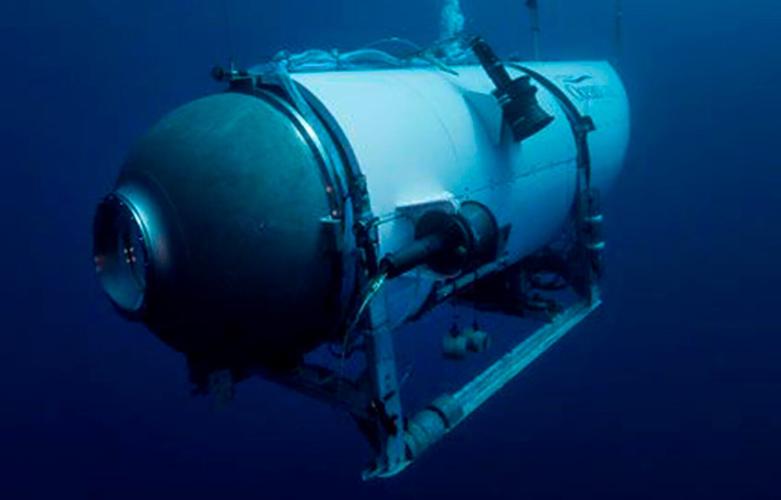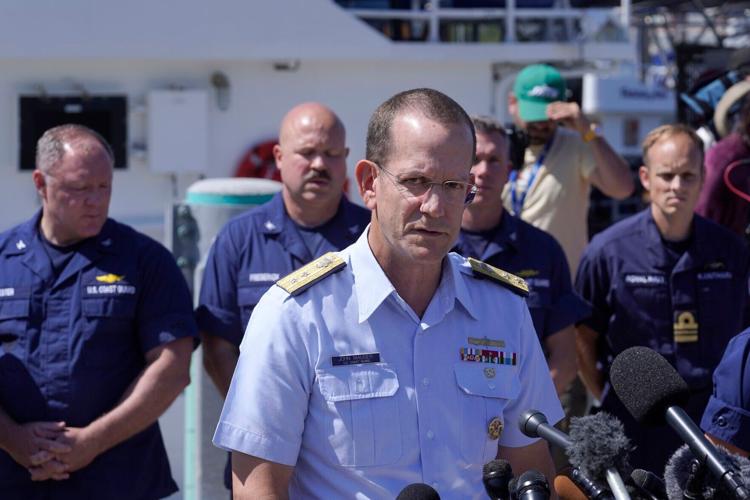The desperate search to find the missing Titan submersible turned into a recovery effort Thursday after officials announced the vessel imploded sometime this week, killing all five aboard, near the Titanic shipwreck.
Deep-sea robots will continue searching the sea floor for clues about what happened deep in the North Atlantic. The pilot and four passengers died in the catastrophic implosion.
The Titan, owned by undersea exploration company OceanGate Expeditions, had been chronicling the Titanic's decay and the underwater ecosystem around the sunken ocean liner in yearly voyages since 2021.
Many questions about what occurred underwater remain: Exactly when and why did the implosion occur? Will the victims' bodies ever be found? How could this tragedy have been prevented?
Here's what we know so far:

FILE - This undated image provided by OceanGate Expeditions in June 2021 shows the company's Titan submersible. Rescuers are racing against time to find the missing submersible carrying five people, who were reported overdue Sunday night. (OceanGate Expeditions via AP, File)
WHEN AND WHERE DID THE TITAN GO MISSING?
The craft submerged Sunday morning, and its support vessel lost contact with it about an hour and 45 minutes later, according to the Coast Guard.
The vessel was reported overdue about 435 miles (700 kilometers) south of St. John's, Newfoundland, according to Canada's Joint Rescue Coordination Centre in Halifax, Nova Scotia.
The Titan was launched from an icebreaker that was hired by OceanGate and formerly operated by the Canadian Coast Guard. The ship has ferried dozens of people and the submersible craft to the North Atlantic wreck site, where the Titan has made multiple dives.
WHAT HAPPENED ABOARD THE TITAN?
The vessel suffered a catastrophic implosion, killing all five aboard, sometime this week after it submerged Sunday morning. It's not clear exactly when or where the implosion occurred. But a senior military official said Thursday that a U.S. Navy acoustic system detected an "anomaly" Sunday that was likely the Titan's fatal implosion.
The Coast Guard announced that debris from the submersible had been found and the end of rescue efforts Thursday, bringing a tragic close to a saga that included an urgent around-the-clock search and a worldwide vigil for the missing vessel.
"The debris is consistent with the catastrophic loss of the pressure chamber," Rear Adm. John Mauger, of the First Coast Guard District, said in a news conference Thursday.

U.S. Coast Guard Rear Adm. John Mauger, commander of the First Coast Guard District, talks to the media, Thursday, June 22, 2023, at Coast Guard Base Boston, in Boston. The missing submersible Titan imploded near the wreckage of the Titanic, killing all five people on board, according to the U.S. Coast Guard. (AP Photo/Steven Senne)
A deep-sea robot discovered the debris, near the Titanic shipwreck, that authorities say came from the submersible.
The senior military official said the Navy went back and analyzed its acoustic data after the Titan was reported missing. That anomaly was "consistent with an implosion or explosion in the general vicinity of where the Titan submersible was operating when communications were lost," the official said.
The official spoke on condition of anonymity to discuss a sensitive acoustic detection system.
The Navy passed on the information to the Coast Guard, which continued its search because the Navy did not consider the data to be definitive.
The Wall Street Journal on Thursday first reported the Navy's involvement.
WHAT'S NEXT AND WHO WAS KILLED?
The Coast Guard will continue searching near the Titanic for more clues about what happened to the Titan.
Officials say there is not a timeframe for when they will call off the massive international search. Mauger said that the prospect of finding or recovering remains was unknown.
The victims are: Oceangate chief executive and Titan pilot Stockton Rush; two members of a prominent Pakistani family, Shahzada Dawood and his son Suleman Dawood; British adventurer Hamish Harding; and Titanic expert Paul-Henri Nargeolet.

This photo combo shows from left, Shahzada Dawood, Suleman Dawood, Paul-Henri Nargeolet, Stockton Rush, and Hamish Harding are facing critical danger aboard a small submersible that went missing in the Atlantic Ocean. The missing submersible Titan imploded near the wreckage of the Titanic, killing all five people on board, the U.S. Coast Guard announced Thursday, June 22, 2023. (AP Photo/File)
"These men were true explorers who shared a distinct spirit of adventure, and a deep passion for exploring and protecting the world's oceans," OceanGate said in a statement. "We grieve the loss of life and joy they brought to everyone they knew."
WHO REGULATES DEEP-SEA EXPEDITIONS?
The Titan's voyage down into the North Atlantic highlights the murkily regulated waters of deep-sea exploration.
It's a space on the high seas where laws and conventions can be sidestepped by risk-taking entrepreneurs and the wealthy tourists who help fund their dreams. At least for now.
The Titan's fatal implosion has drawn attention to how these expeditions are regulated.
The Titan operated in international waters, far from the reach of many laws of the United States or other nations. It wasn't registered as a U.S. vessel or with international agencies that regulate safety, nor was it classified by a maritime industry group that sets standards on matters such as hull construction.
Stockton Rush, the OceanGate Expeditions CEO and Titan pilot who was among the dead, had said he didn't want to be bogged down by such standards.
Experts say wrongful death and negligence lawsuits are likely in the Titan case — and they could be successful. But legal actions will face various challenges, including waivers signed by the Titan passengers that warned of the myriad ways they could die.
HOW MUCH DID THE SEARCH COST?
The cost of the search will easily stretch into the millions of dollars for the U.S. Coast Guard alone. The Canadian Coast Guard, U.S. Navy and other agencies and private entities also rushed to provide resources and expertise.
There's no other comparable ocean search, especially with so many countries and even commercial enterprises being involved, said Norman Polmar, a naval historian, analyst and author based in Virginia.
The aircraft, alone, are expensive to operate.
The Pentagon has put the hourly cost at tens of thousands of dollars for turboprop P-3 Orion and jet-powered P-8 Poseidon sub hunters, along with C-130 Hercules, all utilized in the search.
Some agencies can seek reimbursements. But the U.S. Coast Guard is generally prohibited by federal law from collecting reimbursement pertaining to any search or rescue service, said Stephen Koerting, a U.S. attorney in Maine who specializes in maritime law.
The first priority in search and rescue is always saving a life, and search and rescue agencies budget for such expenses, said Mikki Hastings, president and CEO of the National Association for Search and Rescue.
Rescue agencies don't want people in distress to be thinking about the cost of a helicopter or other resources when a life is in danger.
"Every person who is missing – they deserve to be found. That's the mission regardless of who they are," Hastings said.
___
The future of deep sea research after the loss of Titanic sub, and more of today's top videos
What researchers say will happen to the future of deep sea research after the loss of the Titanic submersible, the iconic Furby is coming back to stores, and more of today's top videos.
Those who research the deep ocean think the loss of the Titan will likely be a setback as people reassess what is considered safe for deep sea…
US toy giant Hasbro has reintroduced the beloved Furby robotic creature, which gained immense popularity a quarter of a century ago.
The summer travel season has begun and these experts share their vacationer predictions. Buzz60’s Chloe Hurst has the story!
A slew of deals, including a landmark decision for GE to jointly make in India engines for fighter jets, were announced.
James Cameron, the director of the 1998 Oscar winning film Titanic, and a submersible maker, said he wished he sounded the alarm earlier about…
Math and reading scores are down for American students. Veuer's Elizabeth Keatinge has more.












